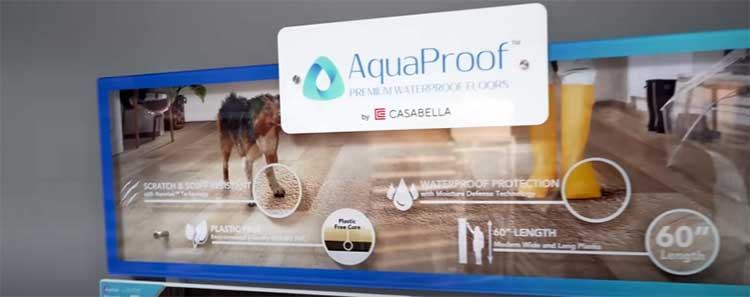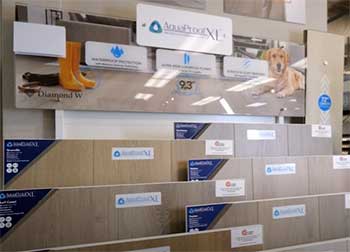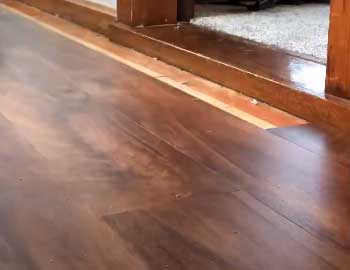I’m standing in my newly renovated kitchen, admiring the sleek, wood-look planks beneath my feet, and I can’t help but grin. AquaProof flooring has transformed my space, and I’m convinced it’s a game-changer for anyone looking to upgrade their home.
It’s durable, stylish, and handles spills like a champ—perfect for my busy household with kids and pets. If you’re on the hunt for flooring that balances beauty, practicality, and affordability, AquaProof is calling your name.
Trust me, you’ll want to keep reading to see why I’m so obsessed with this product.
My Journey With AquaProof Flooring

Picture this: I’m knee-deep in a home renovation, staring at a dizzying array of flooring options, my head spinning from the choices. Hardwood? Too pricey and high-maintenance. Tile? Cold and unforgiving.
Vinyl?
Not quite the vibe I wanted. Then, I stumbled across AquaProof flooring at my local Floor & Decor, and it felt like the universe was giving me a high-five. I chose the Renaissance Oak laminate in a warm, medium-brown tone, hoping it would bring that timeless, cozy aesthetic to my open-plan living space.
Spoiler alert: it delivered, and then some.
Installing AquaProof was a breeze, thanks to its click-lock system. I’m no DIY guru, but with a friend’s help, we laid down 750 square feet in a weekend.
The planks felt sturdy in my hands, and the realistic wood grain had me doing a double-take—could this really be laminate? Once it was down, my living room, kitchen, and hallway felt like they belonged in a magazine.
The color was exactly what I wanted: neutral enough to match my eclectic decor but rich enough to feel luxurious. My toddler immediately tested its durability by spilling juice, and I just wiped it up with a damp cloth—no drama, no damage.
Two years in, my AquaProof floors still look fantastic, though I’ve noticed a few scratches from dragging furniture (my bad). The water resistance is a lifesaver; I’ve mopped, spilled, and even dealt with a minor sink overflow without a hint of warping.
It’s not perfect—there’s a slight creak on one stair, likely from a subfloor issue—but overall, it’s been a dream. My home feels warm, inviting, and practical, which is everything I needed. If you’re weighing flooring options, I’m betting AquaProof will win you over like it did me.
What Makes AquaProof Stand Out?

AquaProof isn’t just another laminate flooring brand—it’s got some serious tricks up its sleeve.
The core of its appeal lies in its water-resistant design.
Unlike traditional laminate, which can swell or warp when exposed to moisture, AquaProof coats its fiberboard core with a melamine layer on the sides and bottom.
This plastic shield makes it a rockstar in kitchens, bathrooms, or homes like mine where spills are a daily occurrence.
I’ve seen my floors shrug off everything from muddy paw prints to my kid’s art project gone wrong.
The aesthetic is another big win. AquaProof offers a range of looks, from classic oak to exotic teak, all without the hefty price tag of real hardwood. I went for a medium-brown shade because I wanted something versatile that wouldn’t clash with my ever-changing decor.
The high-definition printing and embossed texture make it hard to tell it’s not the real deal—my guests are always shocked when I reveal it’s laminate. Plus, it’s certified GreenGuard Gold for low emissions, so I don’t worry about funky chemicals in my air.
That’s a big deal when you’ve got little ones crawling around.
Durability is where AquaProof flexes its muscles. It’s rated AC4, meaning it can handle heavy residential use or even light commercial spaces. My living room gets constant foot traffic, and the floors still look nearly new.
Installation was straightforward, though I learned the hard way that a level subfloor is non-negotiable to avoid issues like popping boards. At $2 to $4 per square foot, it’s a steal compared to hardwood, which can easily hit $10 per square foot.
AquaProof gives you that high-end look without draining your wallet.
The Not-So-Great Parts of AquaProof
- Scratches and Chips Can Happen

No flooring is bulletproof, and AquaProof is no exception.
After two years, I’ve noticed a few scratches, especially in high-traffic areas like my entryway.
One particularly annoying mark came from dragging a chair with some grit stuck to its leg—my fault for not being more careful.
There’s also a small chip near the kitchen island from when we moved a heavy appliance during the remodel. These blemishes aren’t dealbreakers, but they’re a reminder that you need to treat AquaProof with some care. Felt pads on furniture legs are now my best friends.
- Installation Hiccups
While the click-lock system is user-friendly, installation isn’t foolproof. I had a couple of boards that didn’t click together perfectly, leaving tiny gaps that bugged me until I had them fixed.
My contractor also mentioned that AquaProof lacks bullnose pieces for stairs, so we had to use trim pieces glued down with liquid nails. It works, but it’s not as seamless as I’d hoped.
If your subfloor isn’t perfectly level, you might deal with creaking or boards popping up, like one spot near my cabinets. A pro installer can save you headaches here.
- Limited Warranty Specifics
AquaProof’s 30-hour standing water warranty sounds impressive, but it comes with a catch: the floor has to be installed correctly for it to apply. If you DIY and mess up, you might be out of luck. I also found the warranty a bit vague on what constitutes “standing water” versus a full-on flood.
It’s great for spills, but don’t expect it to survive a basement flood. Compared to some brands that offer lifetime residential warranties, AquaProof’s coverage feels a bit conservative, especially if you’re banking on decades of use.
Keeping Your AquaProof Floors Looking Sharp
- Routine Cleaning Is a Breeze
Maintaining AquaProof flooring is so easy it almost feels like cheating. I sweep or vacuum weekly to keep dirt and debris at bay—those little bits of grit can cause scratches if you let them build up. For deeper cleaning, a damp mop with a pH-neutral cleaner does the trick.
I use a cleaner specifically made for laminate floors, and it keeps the surface gleaming without damaging the wear layer. Spills? Just wipe them up promptly, and you’re golden. I’ve even used a steam mop on a low setting, and the floors handled it like champs.
- Protecting Against Scratches
To avoid those pesky scratches, I’ve learned to be proactive. Felt pads under furniture legs are a must—trust me, they’re a small investment for peace of mind. I also keep a rug at the entryway to catch dirt before it gets tracked across the floor.
If you’ve got pets, trim their nails regularly; my dog’s claws haven’t caused issues since I started keeping them short. For heavy furniture, use coasters or sliders when moving things around. It’s all about preventing those tiny abrasions that can add up over time.
- Dealing with Minor Damage
If you do get a scratch or chip, don’t panic. I’ve used a laminate repair kit for small marks, and it blends in well enough that you’d need a magnifying glass to spot the fix.
For bigger issues, like a damaged plank, you might need to replace it entirely, which is doable if you kept spare pieces from the installation.
My contractor fixed a popped-up board with some glue and clear caulk, and it’s held up fine. Regular checks for loose boards or gaps can catch problems early before they worsen.
- Long-Term Care Tips
To keep your AquaProof floors looking fresh for years, avoid harsh chemicals like bleach, which can dull the finish. I stick to a simple cleaning routine and inspect high-traffic areas every few months for wear.
If you live in a humid area, a dehumidifier can help prevent moisture buildup, especially in basements. I also recommend reapplying a sealant to the edges in wet-prone areas like kitchens every couple of years for extra protection.
With a little TLC, these floors can stay stunning for a long time.
How AquaProof Stacks Up Against The Competition?
- AquaProof Vs. Mannington Adura Max Flooring

I’ve walked on Mannington Adura Max in a friend’s home, and it’s a serious contender with its vinyl plank construction.
Adura Max boasts a HydroLoc core, making it 100% waterproof, which is a step beyond AquaProof’s 30-hour standing water resistance.
Spills in my kitchen don’t faze AquaProof, but Adura Max might handle a flooded basement better.
Visually, Mannington’s designs, like their Coastal Way Oak, have a soft, authentic texture that rivals AquaProof’s Renaissance Oak.
However, Adura Max costs $4 to $6 per square foot, pricier than AquaProof’s $2 to $4. Installation is similar—both use click-lock systems—but Mannington’s thicker planks feel a bit more solid underfoot.
AquaProof wins for me because of its lower price and laminate durability, but if you prioritize full waterproofing, Adura Max might be your pick.
- AquaProof Vs. CALI Vinyl Flooring

CALI Vinyl caught my eye for its eco-friendly vibe and bold style. Its GeoCore, made with limestone composite, makes it completely waterproof, outshining AquaProof’s laminate-based water resistance.
I saw CALI’s Longboards collection in a showroom, and the wide, surfboard-inspired planks gave a modern edge that AquaProof’s narrower planks can’t match. Priced at $3 to $5 per square foot, CALI’s cost is close to AquaProof’s, but its lifetime residential warranty beats AquaProof’s shorter coverage.
The downside? CALI’s vinyl feels softer, which some love, but I prefer AquaProof’s firmer laminate feel for my high-traffic home. AquaProof’s broader color range also suited my neutral decor better.
- AquaProof Vs. Mirage Wood Flooring

Mirage Wood Flooring is the luxury option—real hardwood, not laminate or vinyl like AquaProof.
I checked out Mirage’s Herringbone Maple, and its rich, natural grain is stunning, making my AquaProof look like a budget cousin.
Mirage’s price, though, is $8 to $12 per square foot, way above AquaProof’s range.
Hardwood’s warmth is unmatched, but it’s prone to water damage, unlike AquaProof’s melamine-coated core that laughs off spills.
Mirage requires refinishing every few years, while AquaProof just needs a quick mop. For my busy household, AquaProof’s affordability and low maintenance make it the practical choice, but Mirage is tempting if you’re chasing that premium hardwood vibe.
Frequently Asked Questions (FAQ)
Choosing the “best” flooring brand depends on your needs, but I’ve got to give AquaProof a shoutout for its balance of affordability, durability, and style. It’s held up beautifully in my home, handling spills and foot traffic without breaking the bank. If you’re after premium looks, Mohawk’s RevWood offers top-tier realism, while Lifeproof is great for vinyl fans. For budget shoppers, Newton delivers solid quality. Ultimately, it’s about matching the brand to your lifestyle—my vote goes to AquaProof for its all-around performance.
AquaProof takes the crown for me in the laminate world. Its water-resistant melamine coating, realistic wood looks, and AC4 durability make it a standout. RevWood by Mohawk is a close second for its high-end textures and pet-friendly features, but it’s pricier. Newton’s a good budget pick, but its shorter warranty and limited styles don’t quite match AquaProof’s versatility. If you want laminate that looks great and handles real life, AquaProof’s my go-to.
I’m assuming you mean AquaProof, and yes, it’s fantastic! My floors have been through toddler tantrums, pet messes, and clumsy spills, and they still look nearly new after two years. The water resistance is legit—I’ve mopped and wiped without worry. It’s not perfect; scratches can happen if you’re not careful, and installation needs precision. But for the price and performance, AquaProof’s a solid choice for anyone wanting stylish, practical flooring.
AquaProof’s my pick for waterproof laminate. Its melamine coating and 30-hour standing water warranty give me peace of mind in my spill-prone kitchen. BHW Floors’ Waterfront is a strong rival with its long warranty and wide planks, but it’s costlier. RevWood offers great water resistance and premium looks, but again, the price stings. Newton’s affordable but lacks AquaProof’s style range. For a budget-friendly, reliable, and good-looking option, AquaProof’s hard to beat.
Wrapping It Up: Why AquaProof Wins My Heart?
After two years of living on AquaProof flooring, I’m still in love. It’s stylish, tough, and easy to care for, making my home both beautiful and functional. From surviving my kid’s juice spills to looking like high-end hardwood, it’s exceeded my expectations.
If you’re ready to transform your space with flooring that’s practical yet gorgeous, AquaProof is the way to go. Head to Floor & Decor, pick your favorite shade, and get ready to fall in love with your floors.
